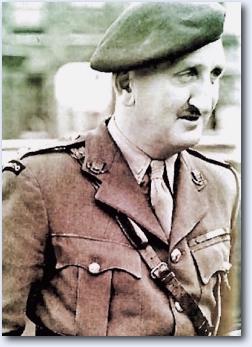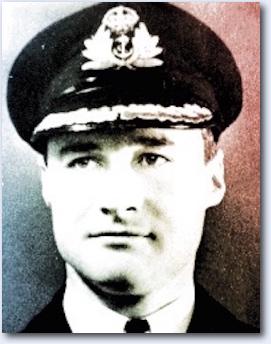 |
|||||
As a 'Combined' Operation, the raid on Saint-Nazaire was constructed around the principle of SEA, LAND and AIR forces working in concert to achieve a specific end - in this case the destruction of the only dry dock on the Atlantic seabord capable of accommodating the mighty German battleship Tirpitz for major repair.
With three services contributing men and materiel, there was always the question of who would be in overall control on the night. The Army Commando force whose task it was to destroy the vital dock facilities, required the Royal Navy to get them there....and, hopefully home again: and right from the start it had always been accepted that, amongst other contributions, RAF Bomber Command would execute a very necessary series of raids to divert attention away from the approaching fleet just as it neared its target. In the event decisions were taken whose potentially deleterious effects on the outcome of the raid seem not to have been given sufficient attention at the time.
Firstly, there would be separate Military and Naval Force Commanders, but no Air Commander: and secondly the Military and Naval Commanders would enjoy equal status, with neither in overall charge of events.
Bearing in mind Bomber Command's ongoing shift in priorities towards strategic bombing and away from the tactical support of other arms, the lack of an Air Force Commander, acting equally and in concert with Military and Naval counterparts resulted in a less than wholehearted RAF contribution, with diversionary raids being carried out by crews who had been both incompletely briefed and saddled with overly-restrictive rules of engagement. As far, however, as the land and sea components were concerned, the almost complete failure of both sea-to-shore and shore-to-shore radio comunications obviated any isues which otherwise might have arisen over tactical priorities, with each commander, once Colonel Newman had been put shore, remaining entirely ignorant of the other's actions and intent.

Married, in 1941, to Hilare Green-Wilkinson, 34-year-old 'Bob' Ryder was a Royal Navy Regular serving, at the time of his appointment, as Naval Liaison Officer to the Army's Southern Command HQ, in the palatial splendour of Wilton House near Salisbury.
Very much imbued with the idea of public service, he was to later write that, 'We came from a Military background and were really proud of it. The thought of working in a city office in the hope of being rich one day had little appeal to our adventurous instincts. We just took it for granted that there was no better way of serving one's contry than in the armed forces of the Crown'.
And, adventurous his instincts indeed were as, while stationed in Hong Kong he and four other officers constructed the ketch Tai Mo Shan and sailed her all the way back to the UK, via the Panama Canal - a perilous episode followed by command, at only 26, of the research ship Penola, a three-masted topsail schooner set for a three-year voyage to the Antarctic.
The coming of war gave Ryder yet another chance to live out the tales of derring-do he had devoured as a boy, with command of a Q-ship and orders to 'Seek out and destroy the enemy'. Sadly however, it transpired to be the reverse, with his ship sunk by a U-Boat, the loss of three-quarters of his people and a lengthy period prior to rescue of clinging alone to a piece of wreckage deep into the Atlantic.
A later command, as captain of the Commando ship Prince Philippe, proved short-lived after she was lost to a collision in fog - this episode initiating the spell at Wilton House, from whose stultifying clutches the call to serve as Naval Force Commander would come as a blessed release,

'Colonel Charles' Newman was 37 at the time of the raid and married to Audrey, with four children already and a fifth on the way (Penelope Jane was born on the day of the attack). A Civil Engineering Contractor prior to the war, he was an enormously talented individual, who loved racing cars, who boxed for the Army as a light-middleweight and who was both a rugby forward and a very proficient golfer. Also, as a talented pianist, he and Audrey published a number of songs together before the war, and while a PoW Newman would write musicals which were then performed in the prison camp Oflag IX A/H.
Newman had spent some 16 years as a Territorial soldier with the 4th Battalion, the Essex Regiment. Early in the war he commanded No. 3 Independent Company with the rank of Major, seeing active service during the abortive 1940 Norwegian campaign. Later in 1940 he became second-in-command of No. 1 Special Service Battalion, and when these unweildy units became Commandos in March 1941, Newman, now a Lieutenant-Colonel, took command of No. 2.
Completely dedicated to his men Newman was an inspired appointment to command of all the raid's ground forces, whose later statement to the effect that '...it was the burning desire to fight as a Commando that filled us', perhaps goes some way towards explaining the particular courage and dash so evidently on display in Saint-Nazaire.
Journalist Gordon Holman, who travelled with Newman on MGB 314 had this to say of him: 'His jolly, easy-going manner, his pipe held loosely in the corner of his mouth, his soft, unhurried, speech, gave hardly a hint of the tremendous courage, determination and power of leadership which he possessed. ....every one of his men believed in him utterly. In addition they had a deep affection for him. He had the same affection (for them). "they are a great bunch" he would say. "I hope we are always together."'
All material contained in this site is subject to copyright and must not be reproduced in any format without the consent of the relevant copyright holder

The Force Commanders